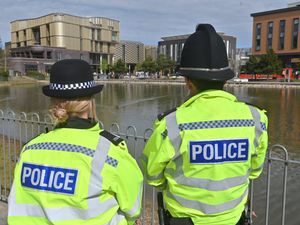Aston Expressway bomb: Controlled explosion carried out on Second World War shell
A Second World War bomb found near the Aston Expressway has been safely detonated, bringing 30 hours of drama to an end.
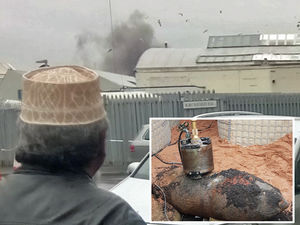
A huge crater was left in the earth when bomb disposal experts carried out a controlled explosion at around 3.35pm today, after soldiers had worked overnight and throughout Tuesday day to make the area safe.
Around 250 tons of sand had been brought onto the building site where the bomb was discovered in Priory Road, Aston, to create a bunker to protect against any shrapnel sent flying in the blast.
Pictures were released showing the shell and protective 'sand bunker' before the explosion was marked by a thumping boom reportedly heard by people as far as six miles away.
An Army spokesman said the unexploded 550lb bomb was one of the largest ever found on British soil.
The explosion sent a plume of dark smoke into the overcast sky which was soon dispersed by the strong breeze and in the minutes after there was a notable tang of cordite in the air.
At a busy roundabout close to the M6 - which was shut between junctions 4 and 7 while the bomb was detonated - some startled drivers got out of their cars to look around in disbelief.
One young child who was walking down the pavement with his mother and siblings when the explosion occurred simply said: "Mummy, that was loud!"
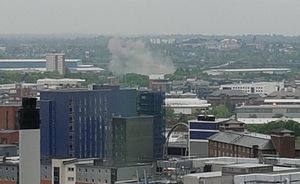
Key points
Second World War bomb discovered on building site in Aston at around 9.45am on Monday.
A38(M) Aston Expressway closed by Monday lunchtime after the discovery was made.
Slip roads at the M6 junction 6 around Spaghetti Junction were also closed.
A 1,600ft (500 metre) cordon was put in place. Businesses and homes were evacuated.
Around 200 people were evacuated with up to 80 residents staying at the Alexander Stadium near Great Barr overnight.
Specialist Army bomb disposal teams were brought in to deal with the device thought to weigh 550lb (250 kg).
250 tons of sand was moved on to the site around the bomb to protect against shrapnel
Controlled explosion of the bomb took place at around 3.35pm.
M6 fully open by around 4pm and Aston Expressway back open by 6pm.
The explosion meant a gradual return to normality for the 200 residents who had been evacuated from the 1,600ft (500 metre) cordon put in place on the advice of explosives experts.
However, although the M6 was reopened after the blast, the key Aston Expressway stayed shut until 6pm - extending traffic disruption which had added 90 minutes onto many people's journeys.
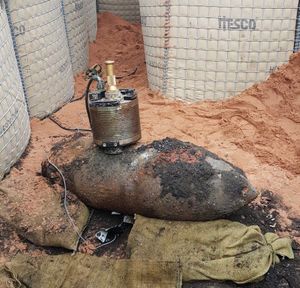
The A38(M) and slip roads off Spaghetti Junction had all been shut since the large German bomb was found on Monday morning, while nearby rail services were also disrupted.
Meanwhile many evacuated residents spent the night at a makeshift shelter in a leisure centre near Great Barr, where they were helped by council staff and Red Cross volunteers.
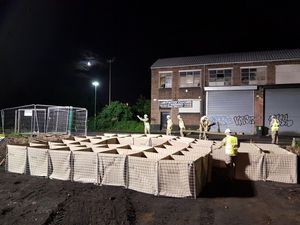
A spokesman for the Army said: “The condition of the bomb ruled out removing it to a safer place to detonate.The two fuses had badly corroded causing explosive material to leak.
"This left the soldiers with only one option – a controlled explosion. A bomb disposal robot called a ‘Cutlass’ was used to carry out checks before detonation.”
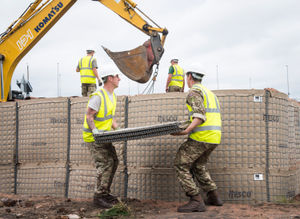
Sgt Paul Daniel of 721 Explosive Ordnance Disposal Squadron, 11 EOD Regiment RLC said: “It was the largest disposal of a device in situ in recent history and was particularly challenging due to its corroded state.”
Historian Carl Chinn told BBC WM he believes the bomb would have been dropped by a Luftwaffe aircraft on the night of either November 19 or 20, 1940.
“This area was bombed very heavily," he said.
“Birmingham was a major munitions centre – there was General Electric, Kynoch, while Dunlop made so many of the tyres that were needed.
“In Aston there were also smaller factories and workshops, next to back-to-back homes.
"It’s most likely that it was dropped on November 19, the worst raid in Birmingham, or the next night, when Queens Road was destroyed by a huge bomb.
“Queens Road is right by where this bomb has been found and it was dropped from 40,000ft – imagine the velocity and the power."
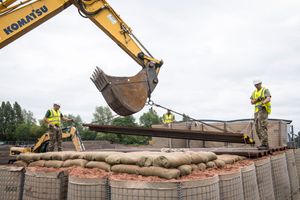
Birmingham Police Commander Chris Johnson thanked the public for their understanding and praised the soldiers who worked near the bomb.
“I fully understand the impact on people’s lives that incidents like this cause. It’s important to remember that brave military staff are risking their safety to ensure that of the public," he said.
Around 200 residents were evacuated from their homes and Ch Supt Johnson said he understood people's frustration.
He said: "I know people have been frustrated with what we've been saying but we have shared with people everything we've known.
"I think people just want to know when they can go home and if they can do X, Y and Z.
"But we are having to step through this really carefully - it's a really old bomb and a really large bomb.
"The military are having to act with precaution."




